Ducks are one of the cutest birds out there, especially when they are still young. It is not much of a surprise to see why some people would adopt them as pets.
But like other animals, they also can be divided into domesticated species and wild ones. Wild ducks are rare and unique compared to the usual ducks we see on a farm.
Some people consider them as trophies and one of the reasons why they are being hunted in the wild is due to their exotic values and how rare they look. From just a mere glance, they certainly look different and come in many sizes, shapes, or forms.
Table of Contents
Rarest Wild Ducks
1. Silver Teal Ducks (Anas versicolor)

The Silver Teal ducks or Versicolor Teal ducks inhabit lakes, grassy wetlands, and reedy marshes. They are one of the species of dabbling duck that can be found in the United States and many regions in South America.
Silver Teals measure between 17 and 19 inches in length weigh around 13 to 16 ounces.
They can be recognized by their blue bill with a yellow patch at the base, blue legs and feet, a black cap that extends below the eyes, and a green speculum. They mostly live in small groups and feed on small vegetation, seeds, and aquatic plants.
2. White-Cheeked Pintail Ducks (Anas bahamensis)
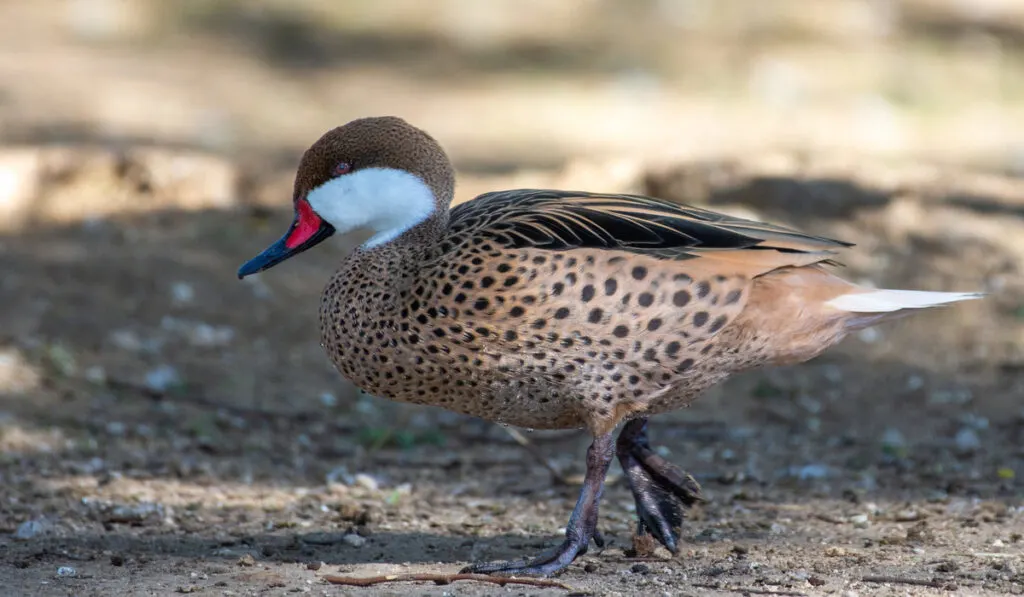
Also known as Bahama Pintails, these ducks are dabbling ducks that inhabit saltwater regions including bay shores, tidal regions, mangroves, and lagoons. But they can also be found in freshwater ponds and shallow marshes.
These ducks measure between 15 and 20 inches in length and weigh around 18 to 20 ounces.
The White-Cheeked Pintail ducks are unique for their distinctive white cheeks, throat, and brown coloration on their crown and body. They have black bills with red patches on each side and their diet mainly consists of small aquatic creatures, insects, and vegetations.
They can be found in the United States and other parts of the world.
3. Northern Pintail Ducks (Anas acuta)
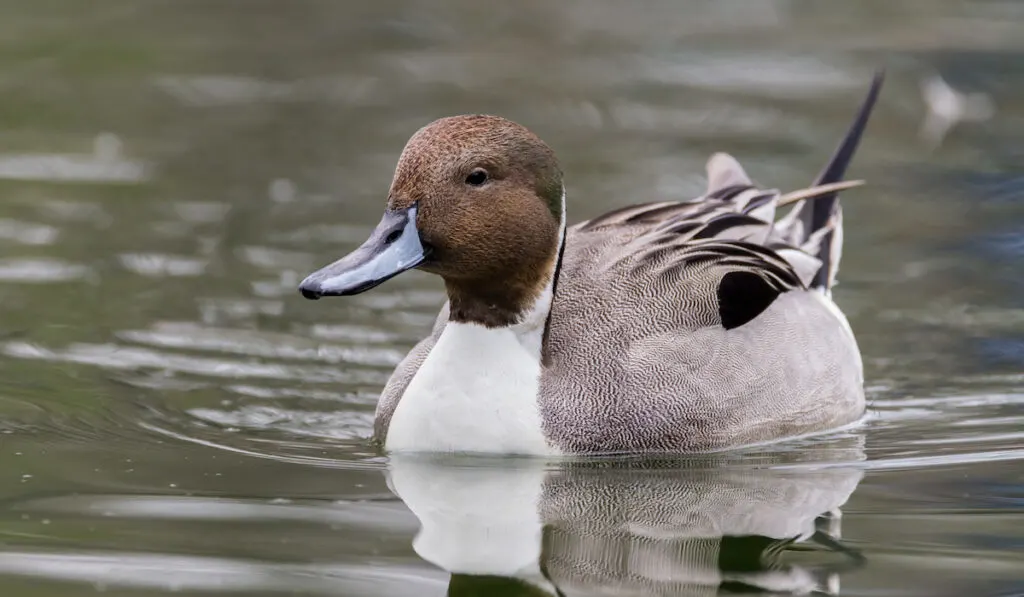
Northern Pintail Ducks are well-known flying ducks that are easily recognized by their thin, long neck and slim body. They possess a brown head, white neck, and body, as well as a black bill.
Male Pintails can be distinguished from females by their two long black tail feathers.
These ducks generally measure between 20 and 30 inches in length and weigh around 1 to 3.2 pounds. Their wingspan can reach up to 34 inches.
Northern Pintail ducks will form a large group during nonbreeding season and feed on grains, seeds, and aquatic insects.
They can be found in the United States and other parts of the world.
4. Barrow’s Goldeneye Ducks (Buchepala islandica)
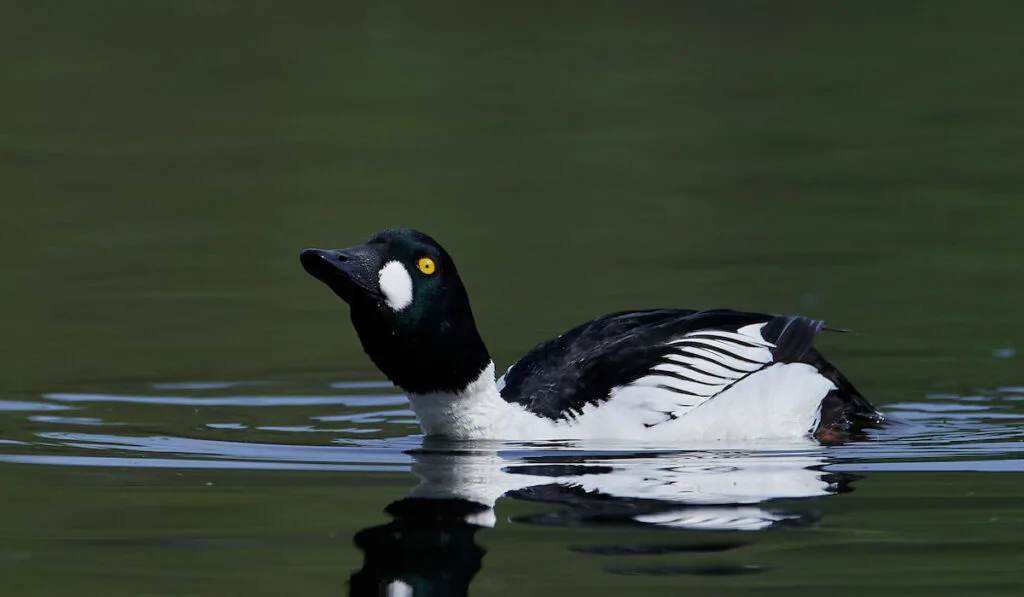
Barrow’s Goldeneyes are medium-sized ducks with a triangular black head and bills, golden to yellow eyes, and grayish-white bodies with crescent-shaped white patches on their face.
Female Goldeneyes have yellow bills, hidden white collars and a slightly larger head than males. These ducks measure between 16.9 and 19.1 inches in length and weigh around 2.2 to 3 pounds.
They usually form a large flock in their natural habitats including lakes, ponds, rivers, as well as protected coastal waters.
Barrow’s Goldeneyes feed on aquatic insects like larvae of dragonflies and caddisflies, crustaceans and mollusks, as well as other plants like pondweeds.
They can be found in small populations in the United States and other parts of the world.
5. Madagascar Pochard Ducks (Aythya innotata)

Considered one of the rarest birds in the world, the Madagascar Porchards are relatively medium-sized brown diving ducks that inhabit lakes, healthy wetland, marshy vegetation, and ponds in northern Madagascar.
These ducks measure between 17.7 and 22 inches and weigh around 24.2 ounces. Aside from having a brown body, they also have a black bill, white eyes, and white markings under the tail.
Their estimated population in this world is less than 50 individuals, which makes them a highly endangered species.
6. Ruddy Ducks (Oxyura jamaicensis)
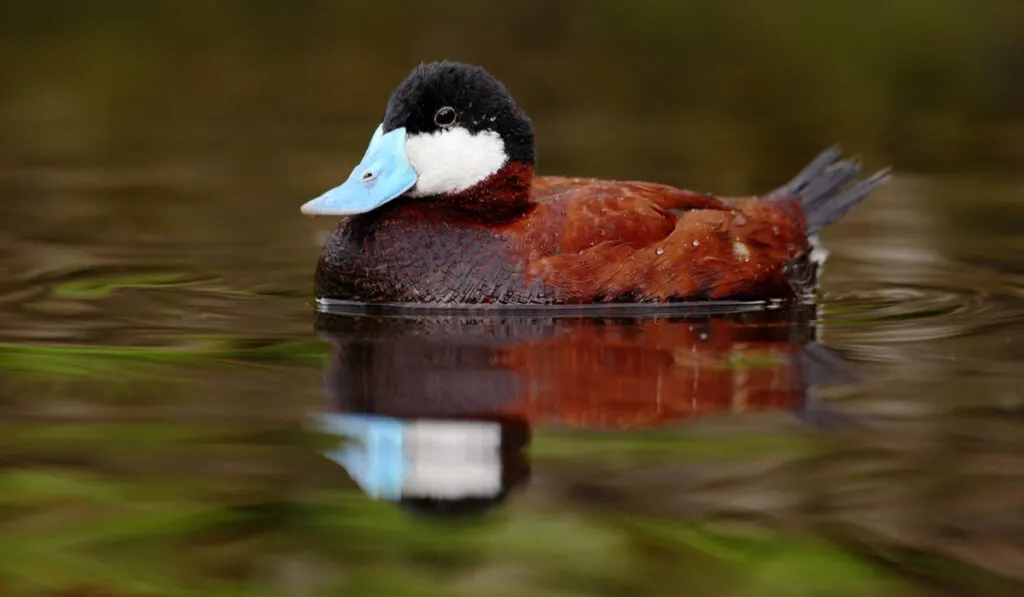
Ruddy ducks can be easily recognized by their distinctive bright blue bills, rusty brown bodies, and stiff, fan-shaped, black feathers on their tails.
These ducks measure up to 15 inches in length and weigh around 1.2 pounds.
They generally inhabit fresh ponds, marshes, lakes, alkaline lakes, and will migrate to protected shallow bays and estuaries along the coast in the winter.
Ruddy ducks rarely group or mix with other ducks and mostly feed on seeds, roots of plants, insects, pondweeds, aquatic insects, as well as mollusks and crustaceans.
They can be found in small populations in the United States and other parts of the world.
7. American Black Ducks (Anas rubripes)

The American Black ducks are large dabbling ducks that can be commonly found throughout eastern North America. Although they are named black ducks, these ducks are actually dark brown in color.
Some people would call them the ‘Dusky Duck’ due to their dusky dark brown plumage. The male ducks are slightly different than females. They have yellow-green bills while females have olive-colored bills.
These ducks measure between 21 and 22 inches in length and weigh around 2.4 to 2.7 pounds.
American Black Ducks inhabits many places including alkaline and brackish marshes, clear lakes, bays, and the margins of estuaries.
8. Baer’s Pochard Ducks (Aythya baeri)
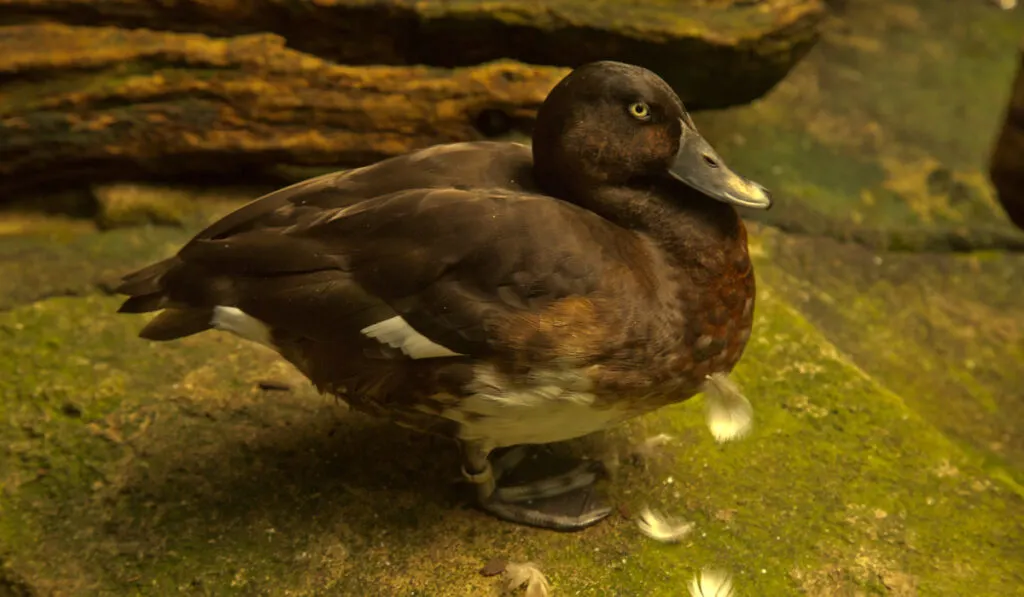
Baer’s Pochard ducks are considered one of the world’s rarest and endangered duck species. These diving ducks are native to Eastern Asia and breed in northeast China and southeast Russia.
Both sexes of Baer’s Pochards possess a green-glossy dark head that appears brown or black under normal light. They have blue eyes, chestnut brown chests, and white coloration on each side of their bodies.
These ducks measure between 16 and 18 inches in length and weigh around 1.5 to 2.1 pounds.
Baer’s Pochards inhabit sheltered and well-vegetated lakes and feed on plants, aquatic insects, crustaceans, and mollusks.
Their estimated population in the world is only around 150 to 700 individuals.
9. Common Eider Ducks (Somateria mollissima)
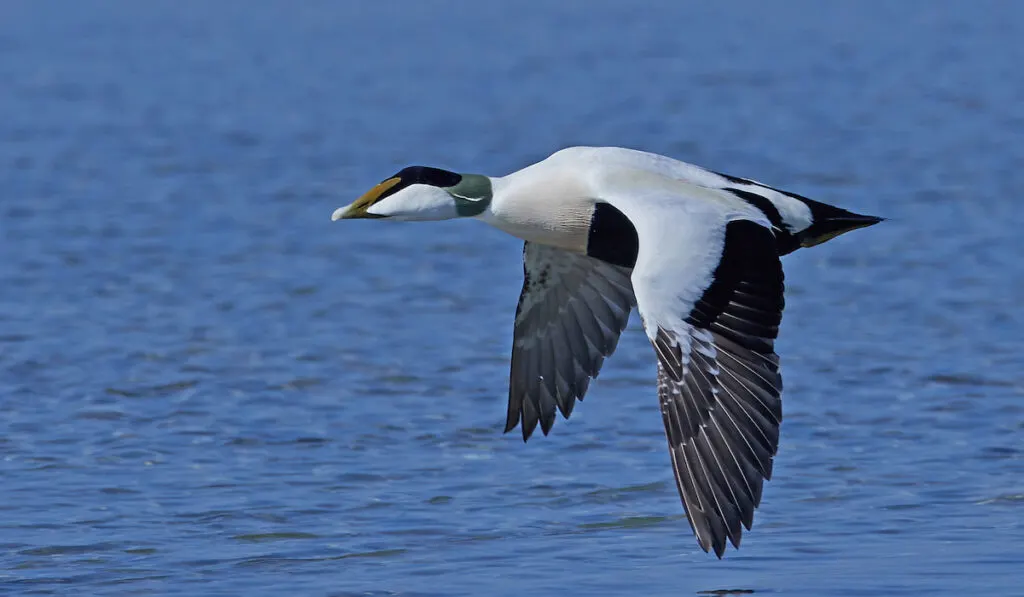
Common eiders are large-sized, flying ducks that inhabit the coastal islands, ponds, and lagoons near the ocean. They are one of the true seaducks with a large body, a black crown, a white back, and black coloration on each side of their body.
Females eiders are different males with their body and plumage that are mostly in a reddish-brown color.
Common eiders generally measure between 21 to 24 inches and weigh around 4 to 7 pounds. Because of their size, they are often mistaken for geese.
Their diet consists of many marine creatures including mollusks, fish, crustaceans, and other marine invertebrates.
They can be found in the United States and other parts of the world.
10. Cinnamon Teal Ducks (Spatula cyanoptera)
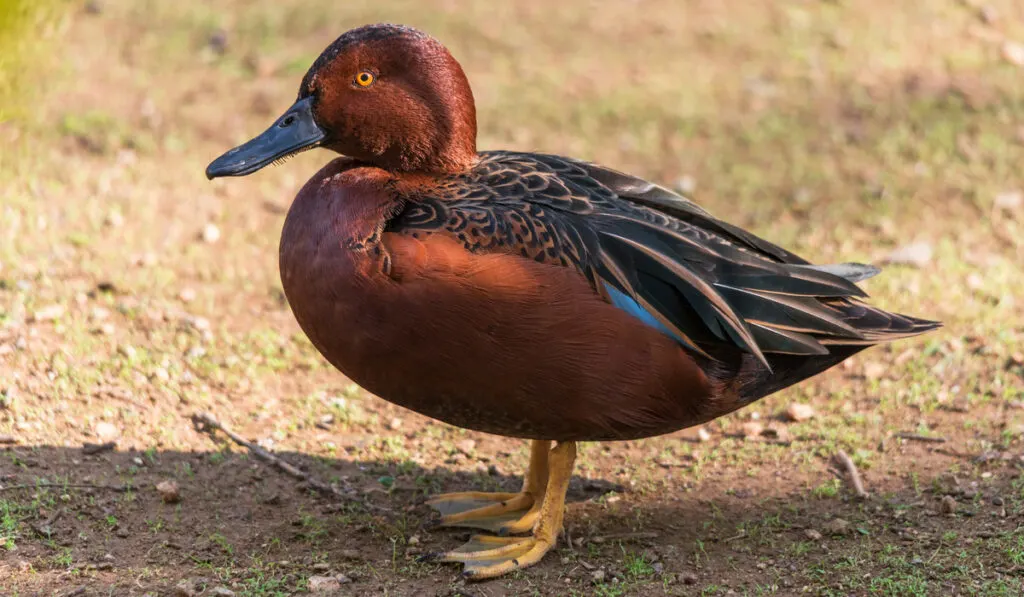
Cinnamon Teal ducks inhabit many small lakes, marshes, fresh ponds, and shallow alkaline wetlands that are covered with low herbaceous plants. They can be recognized by their distinctive cinnamon-red head bodies, long black bills, and red to orange eyes.
Female Cinnamon Teals are slightly different from males with their pale brown bodies and faint darker eye lines. These ducks could grow up to 15 inches in length and weigh around 0.7 pounds.
They mostly feed on seeds and vegetations like smartweeds, pondweeds, as well as small insects and crustaceans. They can be found in small populations in the United States and other parts of the world.
11. Brazilian Merganser Ducks (Mergus octosetaceus)
These rare and endangered ducks are extremely different than any other species. They possess an iridescent dark green head, long black bills, white wing panels, and spiky crest. Brazilian Mergansers inhabit clearwater rivers with abundant fish, in which they dive to catch their food.
They generally nest in tree cavities, rock crevices, and abandoned burrows made by other terrestrial animals. They grow up to 22 inches in length and weigh around 21.2 to 24.7 ounces.
Brazilian Mergansers are mostly being cared for and conserved in Brazil because of the rapid decline in their population. As of today, it is estimated that there are only 250 of these ducks left in the world.
12. Long-Tailed Ducks (Clangula hyemalis)
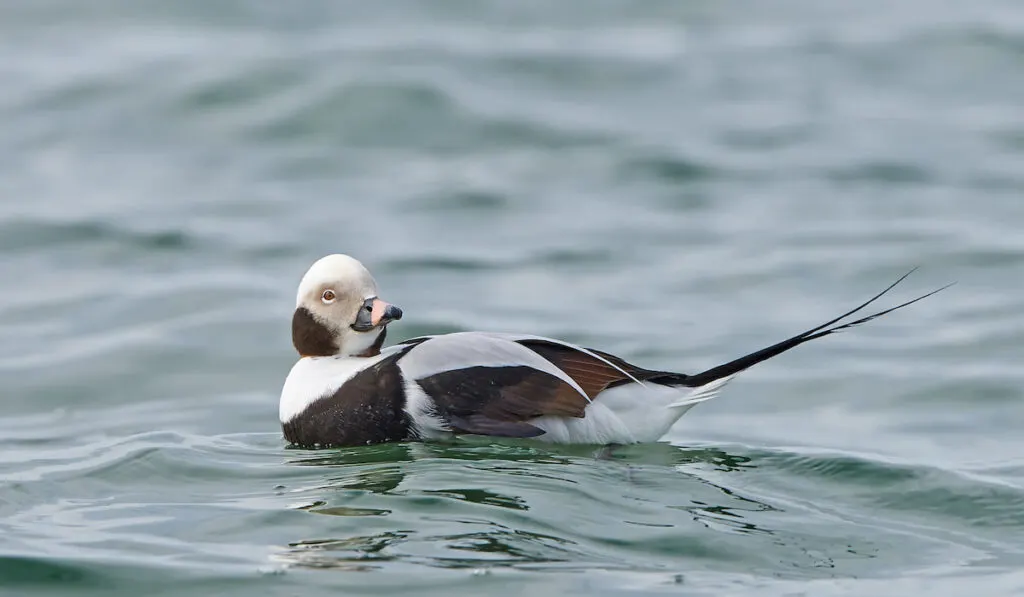
Long-tailed ducks inhabit different types of regions including large lakes, oceans, open water in the northern forest, but they prefer saltwater areas in winter and Arctic tundra pools in the summer.
These male long-tailed ducks can be recognized for their distinctive black, white, brown, and gray patterns on their bodies.
Meanwhile, female long-tailed ducks possess brown bodies and slightly whiter faces with dark cheek patches. Both sexes have long feathers on their tail that point upward.
These ducks measure between 17.5 and 23.5 inches in length and weigh around 1.63 pounds. Being excellent divers, long-tailed ducks can dive as deep as 200 feet to forage and catch their food. They mostly feed on mollusks, crustaceans, small fish, aquatic insects, as well as grasses and pondweeds.
They can be found in the United States and other parts of the world.
13. Canvasback Ducks (Aythya valisineria)
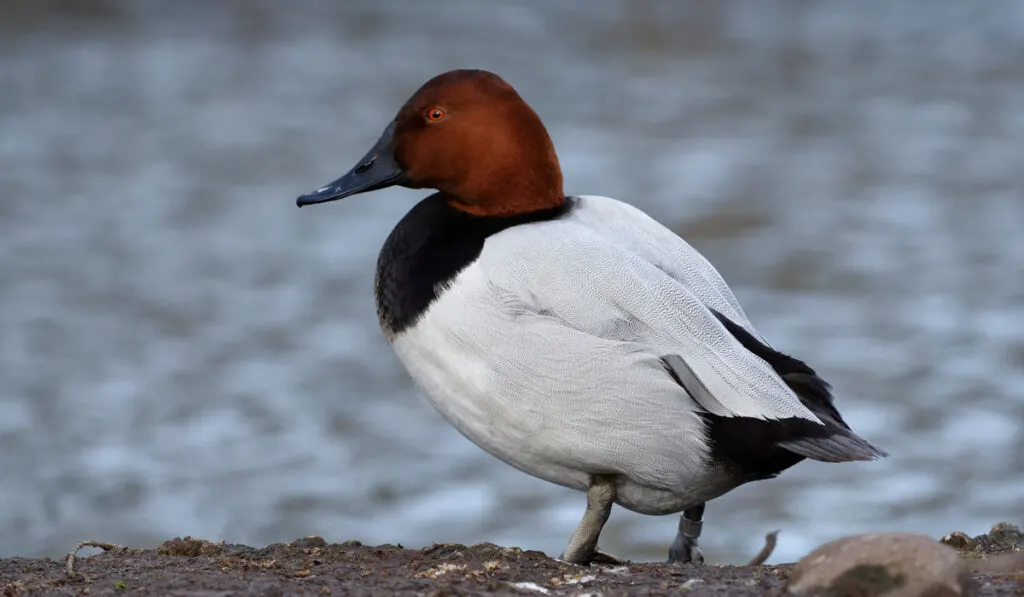
Canvasback ducks are large diving ducks with large flippers, stout necks, and sloping foreheads. Male Canvasbacks possess a chestnut-red head, dark chest, red eyes, and a white wing and body while females have slightly a slightly pale body with dark eyes.
Both sexes have long black bills. These ducks grow up to 20 inches in length and weigh around 2.5 pounds. They mostly inhabit protected marshes that are covered with vegetation, lakes, slow-flowing rivers, and ponds.
Canvasback ducks spend most of their time in the water and feed on crustaceans, mollusks, aquatic insects, clams, and stems and roots of aquatic plants.
Although their population is declining, they still can be found in the United States and other parts of the world.
14. Harlequin Ducks (Histrionicus histrionicus)
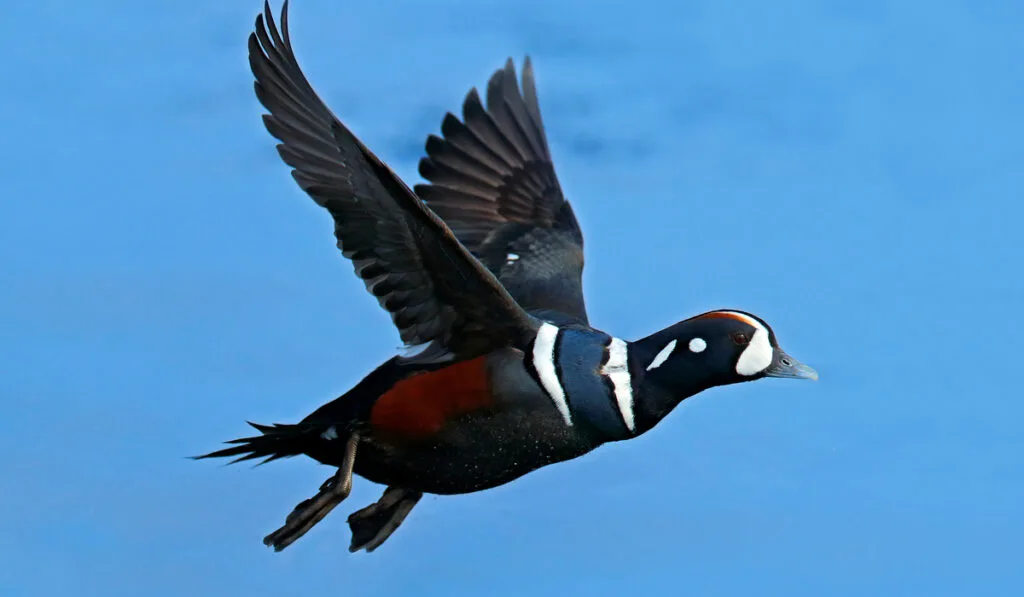
Also known as the rock ducks, sea ducks, white-eyed divers painted ducks, and glacier ducks, these small sea ducks are excellent divers in rough, fast-flowing streams and rivers with vegetation.
They measure between 14 and 20 inches in length and weigh around 1 to 1.5 pounds.
Male Harlequins possess blue-grey bodies with chestnut flanks and white patches on the head and body. Meanwhile, female Harlequins don’t have any speculum and white markings on their wings.
These ducks mainly feed on aquatic invertebrates, plants, mollusks, crustaceans, and smaller fish.
Harlequin ducks can be found in the United States and other parts of the world.
15. King Eider Ducks (Somateria spectabilis)
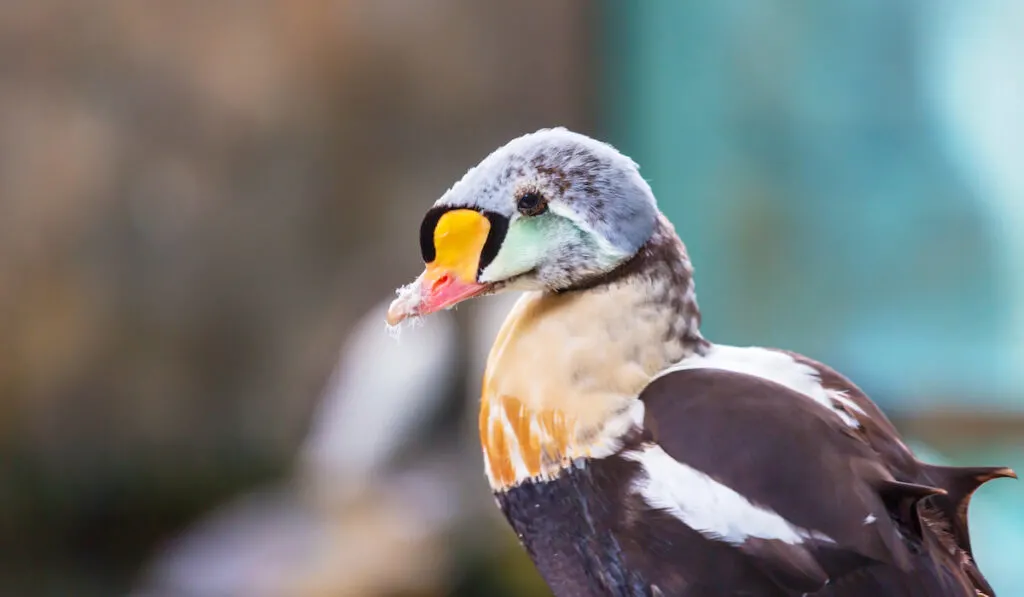
King eiders are sea ducks that inhabit small lakes and ponds before migrating south during winter and north in summer, similar to other sea ducks. They are called ‘the king of eiders’ due to the distinctive crown-shaped color pattern on their head.
These medium to large-sized ducks are foraging omnivores that feed on a variety of marine invertebrates, insects, and aquatic plants.
King eiders measure between 21 and 23 inches in length and weigh around 3.5 to 3.7 pounds. They have a pearl-blue crown, black and white plumage, green cheek, as well as red to orange bills.
These ducks can dive as deep as 80 feet and forage on the sea beds. They are found in small populations in the United States and other regions in the world.
16. Black-Bellied Whistling Ducks (Dendrocygna autumnalis)
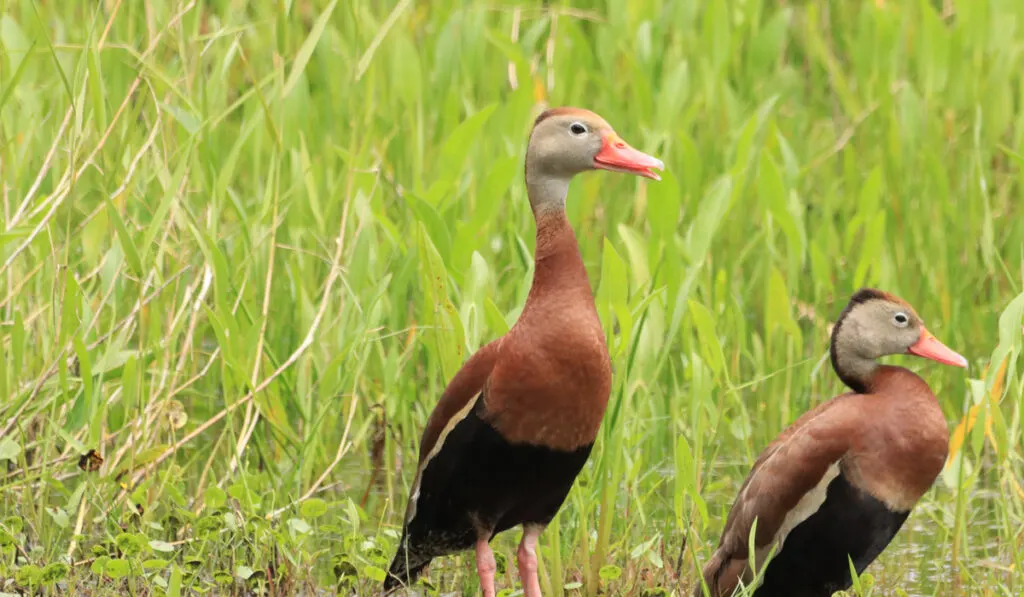
These ducks can be mistaken for exotic geese but they are actually common in tropical habitats. Black-bellied whistling ducks are small to medium-sized flying ducks with long necks and legs. They can be easily identified by their chestnut-black bodies, white-striped wings, and gray bills and legs.
They generally measure between 19 and 22 inches in length and weigh around 1.5 to 1.8 pounds. Black-bellied whistling ducks can be found in the United States and other parts of the world.
They inhabit shallow freshwater lakes, ponds, and fresh marshes. These ducks mainly feed on seeds, grains, grasses, and occasionally, some crustaceans and aquatic insects.
17. Red-Breasted Merganser Ducks (Mergus serrator)
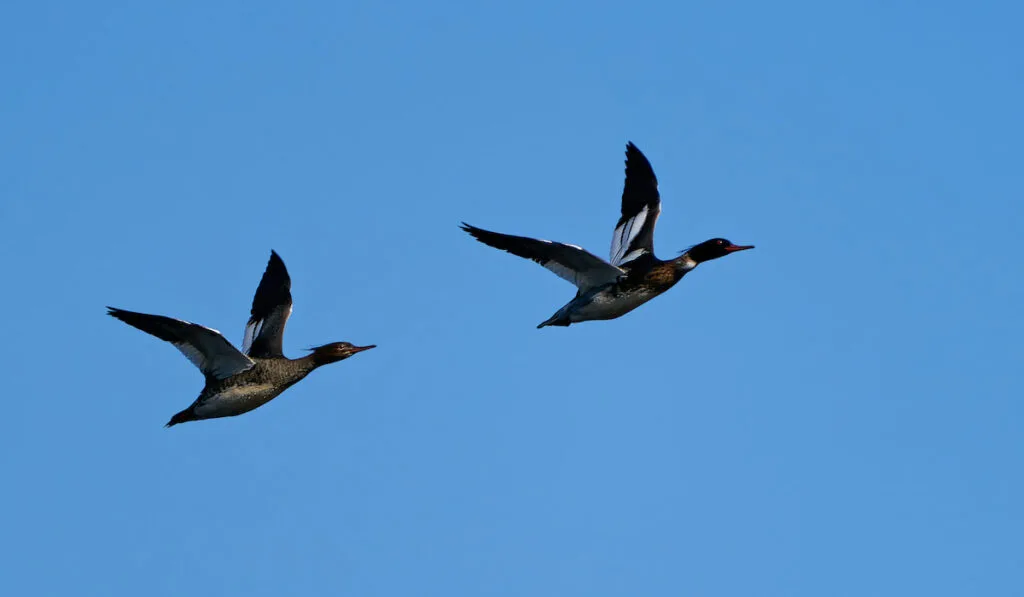
Red-breasted mergansers are large diving ducks that inhabit saltwater regions, wetlands, open bodies of water, and brackish marshes. They have long orange bills, dark green heads, brown chests, gray flanks, and a greenish-black back with a white patch.
These ducks measure between 20 and 25 inches in length and weigh around 1.8 to 3 pounds. But male mergansers are slightly larger than females.
Red-breasted mergansers mostly feed on fish, crustaceans, aquatic insects, and occasionally, frogs and tadpoles.
They can dive as deep as 30 feet and stay underwater around 44 seconds long. These ducks can be found in some regions in the United States and other parts of the world.
Rare Duck Populations
Of these 17 ducks, only 14 of them can be found in the United States. So, some people might be wondering which duck is considered the rarest species in America?
The Laysan duck is the rarest duck in North America and they are critically endangered. Their estimated population is only estimated to be under 700 total birds.
This table shows the estimated population of these rare duck species in the United States and where they can be naturally found.
| Species | Estimated Population | Location |
| Silver Teal Ducks | At least 50,000 to 100,000 | South Georgia, South Sandwich Islands, Falkland Islands, Bolivia, southern Brazil, Paraguay, Argentina, Chile, and Uruguay. |
| White-Cheeked Pintail Ducks | Around 75,000 to 100,000 | North regions of the United States, in the Carribean, South America, and the Galapagos Islands. |
| Northern Pintail Ducks | Around 3.2 million | In the North and West parts of North America, as well as Southern states of America, and Mexico. |
| Barrows Goldeneye Ducks | Around 150,000 to 200,000 | In the North West of United States, east of South Carolina, Alaska, and parts of Canada. |
| Ruddy Ducks | Around 750,000 | In the East Coast of the United States and interior wetlands of southern states, as well as in Mexico. |
| American Black Ducks | Around 275,000 | North-East and South-East regions of the United States. |
| Common Eider Ducks | Around 150,000 to 300,000 | As far south as the coast of Virginia, along the coasts of Alaska and Greenland. |
| Cinnamon Teal Ducks | Around 100,000 to 300,000 | On the West Coast and Midwest of United States (especially near the Great Salt Lake, Malheur Basin, and San Luis Valley), Mexico, Peru, and South America. |
| Long-Tailed Ducks | Around 1 million | In the North Carolina and Northern California. |
| Canvasback Ducks | Around 700,000 | In the Northern and Southern United States, Alaska, Mexico, and eastern Canada. |
| Harlequin Ducks | Around 1 million | On the west coast of central California, east coast of Maryland, south to Wyoming, California, and Massachusetts, along the coast of Greenland, Newfoundland, and northern Quebec. |
| King Eider Ducks | Around 275,000 | In the North America, along the Alaskan coast, from Canadian coast to Greenland, and as far south as Florida. |
| Black-Bellied Whistling Ducks | Around 1.1 to 2 million | Southern Texas, Florida, and the coasts of Mexico |
| Red-Breasted Merganser Ducks | Around 375,000 | North America, from Alaska to Mexico, from Greenland to Florida, and northern Canada |
Rarest Domestic Ducks In The United States
Aside from wild ducks, some of the rarest ducks in the United States are also domesticated on farms and poultries.
These rare domestic ducks are also endangered due to the decline in their population.
1. Saxony Ducks

Saxony ducks are multi-purpose ducks raised and bred for their meat, eggs, and also as show ducks. These rare and endangered domestic ducks have silver or blue-gray heads and back, white flanks, chestnut-brown chest, white neck ring, and orange feet.
Saxony ducks grow up to 9 pounds and lay around 190 to 240 eggs per year. Although they can’t fly, Saxonies are excellent foragers and help reduce the number of slugs and snails on the farm.
Being a hardy breed, these ducks are docile, easy-going, and don’t need much attention for them to grow healthily.
2. Silver Appleyard Ducks
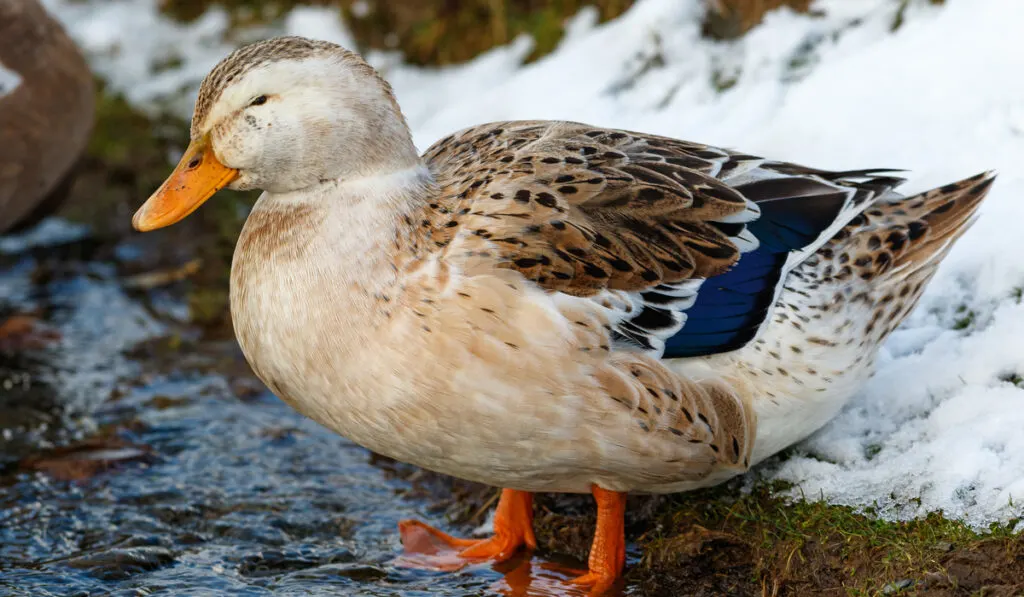
Silver Appleyard ducks are large and sturdy dual-purpose with males having greenish-black heads and females having silver-white heads, yellow bills, chestnut-white bodies, black tails, and orange to red feet. This hardy breed is raised for its meat and eggs.
Silver Appleyard ducks grow up to 9 pounds and lay around 200 to 270 eggs per year.
These endangered domestic ducks are raised conserved in the Warrior’s Farm in North Georgia. Aside from being immune to diseases, they are quite docile, calm, and easy to handle.
3. Buff Orpington Ducks
Buff Orpington ducks are well-known for being a dual-purpose breed. These rare and endangered domestic ducks are raised for meat production and used by chefs in high-end restaurants. They mostly come in buff or light brown color with gray to faded-brown bills and yellow feet.
Buff Orpingtons grow up to 8 pounds and live around 8 to 12 years. They are docile, easy to get along with people, and lay between 150 to 220 eggs per year.
These ducks are raised and conserved by some poultry farms in the United States to keep this heritage ducks’ population from declining.
4. Cayuga Ducks

These rare domestic ducks were named after Lake Cayuga in the western part of New York, United States. They were developed by mixing three different breeds; the wild black duck, the Black East India, and the Rouen.
Cayuga ducks are easily recognized by their black plumage, legs, and bills, with greenish black heads and necks.
Being a hardy breed, these domestic ducks grow up 7 or 8 pounds and are mainly raised for their meat and eggs. They generally lay around 100 to 150 eggs per year.
Cayuga ducks can adapt to cold weather and are easy to handle.
5. Bali Ducks
Bali ducks are one of the rare and endangered domestic ducks that hail from the Islands of Bali in the east of Java. Also called the Balinese Crested ducks, they are quite unique due to their clean, bright white bodies and crest, as well as yellow bills and feet.
Bali ducks grow up to 4 or 5 pounds.
They are well-known for being multipurpose ducks and raised for their meat, eggs, and used in exhibitions. Healthy Bali ducks lay around 140 to 200 eggs per year.
Raising these ducks is quite easy due to their docile and easy-going nature.
Although they are good foragers, Bali ducks are not great mothers. Hence, breeders of this breed must put enough focus on taking care of the ducklings.
6. Shetland Ducks
Shetland ducks are rare and critically endangered ducks that originated from the Shetland Islands off Scotland. These small and light breed ducks are raised mainly for their eggs.
They generally grow up to 4 or 4.4 pounds and lay around 150 eggs per year. Shetland ducks possess an iridescent glossy black plumage and white chest. Some white spots can also be found on their heads. These ducks are a hardy breed and excellent foragers.
They are also docile, calm, and easy to raise. Since they are one of the rarest domestic breeds, a special license must be acquired for anyone who wants to raise and conserve these ducks.
Final Thoughts
Like other rare animals, it is no doubt that rare ducks are also endangered due to extreme hunting activities or the disruption of their natural habitats and ecosystem.
Conserving and preserving these exotic species from extinction is crucial to restoring their population, at least to some sustainable degree.
But above all, we should cherish and protect the beauty of all these animals because they are definitely a blessing to the world!
Resources
- https://backyardpoultry.iamcountryside.com/poultry-101/four-threatened-duck-breeds/
- https://www.harteman.nl/pages/mostendangeredwildfowl
- https://www.raising-ducks.com/duck-breed-guide/
- https://omegaoutdoors.blog/rare-duck-species/
Silver Teal Ducks
- https://www.harteman.nl/pages/anasversicolor
- https://ebird.org/species/siltea1
- https://www.purelypoultry.com/silver-teal-ducks-p-1223.html
White-Cheeked Pintail Ducks
- https://animaldiversity.org/accounts/Anas_bahamensis/
- https://ebird.org/species/whcpin
- https://animalcorner.org/animals/galapagos-white-cheeked-pintail-duck/
Northern Pintail Ducks
- https://www.ducks.org/conservation/waterfowl-research-science/photo-essay-the-northern-pintail
- https://www.nwf.org/Educational-Resources/Wildlife-Guide/Birds/Northern-Pintail
- https://www.allaboutbirds.org/guide/Northern_Pintail/id
Barrows Goldeneye Ducks
- https://www.audubon.org/field-guide/bird/barrows-goldeneye
- https://ebird.org/species/bargol
- https://www.allaboutbirds.org/guide/Barrows_Goldeneye/id
Madasgar Pochard Ducks
- https://ebird.org/species/madpoc1
- https://waronwildlife.co.uk/2020/01/27/madagascar-pochard-the-worlds-rarest-duck/
- https://www.birdwatchingdaily.com/news/species-profiles/rare-madagascar-pochard-takes-step-toward-recovery/
Ruddy Ducks
- https://www.audubon.org/field-guide/bird/ruddy-duck
- https://www.allaboutbirds.org/guide/Ruddy_Duck/id
- https://www.rspb.org.uk/our-work/policy-insight/species/invasive-non-native-species/ruddy-ducks-and-white-headed-ducks/
American Black Ducks
- https://www.allaboutbirds.org/guide/American_Black_Duck/id
- https://www.hww.ca/en/wildlife/birds/american-black-duck-1-2.html
- https://www.ducks.org/hunting/waterfowl-id/american-black-duck
Baer’s Pochard Ducks
- https://ebird.org/species/baepoc1
- https://www.bluecreekaviaries.com/baers-pochard
- https://www.eaaflyway.net/identification-of-baers-pochard-aythya-baeri-and-baers-type-birds/
Common Eider Ducks
- https://animaldiversity.org/accounts/Somateria_mollissima/
- https://www.rspb.org.uk/birds-and-wildlife/wildlife-guides/bird-a-z/eider/
- https://www.allaboutbirds.org/guide/Common_Eider/id
Cinnamon Teal Ducks
- https://www.ducks.org/hunting/waterfowl-id/cinnamon-teal
- https://ebird.org/species/cintea
- https://www.allaboutbirds.org/guide/Cinnamon_Teal/id
Brazilian Merganser Ducks
- https://ebird.org/species/bramer1
- https://www.oiseaux.net/birds/brazilian.merganser.html
- https://endangeredlist.org/animal/brazilian-merganser/
Long-Tailed Ducks
- https://www.allaboutbirds.org/guide/Long-tailed_Duck/overview
- https://www.audubon.org/field-guide/bird/long-tailed-duck
- https://ebird.org/species/lotduc
Canvasback Ducks
- https://www.nationalgeographic.com/animals/birds/facts/canvasback
- https://www.allaboutbirds.org/guide/Canvasback/id
- https://www.ducks.org/hunting/waterfowl-id/canvasback
Harlequin Ducks
- https://ebird.org/species/harduc
- https://animaldiversity.org/accounts/Histrionicus_histrionicus/
- https://www.allaboutbirds.org/guide/Harlequin_Duck/id
King Eider Ducks
- https://www.ducks.org/hunting/waterfowl-id/king-eider
- https://oceana.org/marine-life/seabirds/king-eider
- https://www.allaboutbirds.org/guide/King_Eider/overview
Black-Bellied Whistling Ducks
- https://www.thespruce.com/black-bellied-whistling-duck-386362
- https://www.audubon.org/field-guide/bird/black-bellied-whistling-duck
- https://ebird.org/species/bbwduc
Red-Breasted Merganser Ducks
- https://www.rspb.org.uk/birds-and-wildlife/wildlife-guides/bird-a-z/red-breasted-merganser/
- https://www.audubon.org/field-guide/bird/red-breasted-merganser
- https://animaldiversity.org/accounts/Mergus_serrator/
Saxony Ducks
- https://www.raising-ducks.com/duck-breed-guide/saxony-duck/
- https://poultrykeeper.com/duck-breeds/saxony-ducks/
- https://livestockconservancy.org/index.php/heritage/internal/saxony
Silver Appleyard Ducks
- https://morningchores.com/silver-appleyard-duck/
- https://www.newlifeonahomestead.com/silver-appleyard-duck-breed/
- https://livestockconservancy.org/heritage-breeds/heritage-breeds-list/silver-appleyard-duck/
Buff Orpington Ducks
- https://www.raising-ducks.com/duck-breed-guide/buff-orpington-duck/
- https://www.newlifeonahomestead.com/buff-orpington-duck-breed/
- https://petkeen.com/buff-orpington-duck/
Cayuga Ducks
- http://afs.okstate.edu/breeds/poultry/ducks/cayuga
- https://www.omlet.com.au/breeds/ducks/cayuga
- https://livestockconservancy.org/index.php/heritage/internal/cayuga
Bali Ducks
- https://www.raising-ducks.com/duck-breed-guide/bali-duck/
- https://poultrykeeper.com/duck-breeds/bali-ducks/
- http://domestic-waterfowl.co.uk/bali.html
